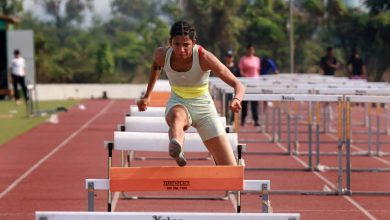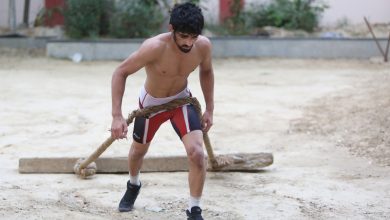The Glasgow Girls: Saina Nehwal, PV Sindhu raise the level of India’s game

As India’s shuttle champs Saina Nehwal and PV Sindhu play for a spot in the World Championship final, a look at how the two raised the level of India’s game
If this is what two women, rumored to be envious of the other’s success and desperate to outdo each other look like, God, let Indian sport boast many such cut-throat rivalries. If this is the purring success a never-escalated, dormant unarticulated catfight can bring, then may this country’s sports-scape be full of such fantastic felines.
And if a glorious Glasgow Saturday semi finals evening at Emirates Arena promises a roaring homecoming for India’s golden girls in badminton PV Sindhu and Saina Nehwal, then may the cheers ringing out of Celtic’s Parkhead cauldron sound akin to what the two would have garnered at Gachibowli. Two semi finalists – out of four – for India at the World Championships is not just the simple doubling of India’s medal count. This weekend ought to celebrate two careers that have fed off each other’s rising ambition to reset themselves higher targets and spawned stupendous global-level bonafide success for the country.
When Saina takes on Nozomi Okuhara earlier in the day, she is sure to lead the way for PV Sindhu who runs into Chinese Chen Yufei later in the night. ‘Friendships’ are for sports’ ‘civvies’ who went shopping for bands start of this month. Who needs those when you could be competing for a medal around the neck by end-August instead?
The rivalry is playdough in hands of anyone who follows badminton in India. You could give it any form you’d want, scribble anything inside their thought bubbles and finally speculate all the way till Tokyo Games and beyond on what Saina and Sindhu think of each other.
In Glasgow where the two arrived separately and are tough to catch in one frame, this competing has given India two medals. Sindhu was expected to win, Saina was the dark horse, but it is a testament to just how high the two’ve set standards for themselves that at the business end the duo are the last Indians standing.
Sindhu was severely tested by Cheung Ngan Yi of Hong Kong on Thursday – the Hong Kong girl playing one of her best matches of unadulterated attacking blitz on the Indian, enroute Saturday’s semis. The tall Sun Yu would offer some respite in the quarters by barely moving only for a Last 4 matchup for Sindhu with the newest highly-rated Chinese Chen Yufei. Considered a player with immeasurable conviction in her strokes, bearing composure through the big games and confident of what she’s doing on court, Chen is China’s most coherent challenge thrown to the world in the coming years. Coach Zhang Nin – who won the 2004 – 2008 double gold and who slaps into shape young women’s singles games, is mighty excited about her ward, and even before she beat the talented Ratchanok Intanon, the 19-year-old was on coach Gopichand’s radar as a likely threat in the semis.
Nehwal bossed Sung Ji Hyun in the pre-quarters like only she can. She enjoys playing the rally game because she has in her end-game, a trusted kill. It was against Kirsty Gilmour in the quarters that Saina was surprisingly stretched 21-19, 18-21, 21-15 as she fought for a medal that Sindhu had just hours ago ensured. Okuhara is a retrieving machine, relentless and untiring. But India has come to expect these two women to deliver everytime they step forward to play, and they aren’t in the habit of letting these slip.
One bronze is so 2011-14, even one silver is really just 2015-16. Only two assured medals could’ve lit up the 2017 script. While Sindhu and Saina have taken turns to brighten alternate tourneys, at Glasgow both managed to check in.
While Cheung had drawn the best out of Sindhu, it was local girl Kirsty Gilmour’s turn to test the Indian. Gilmour lives exactly 15 minutes from the Emirates Arena at Glasgow’s east end and had a stadium full of people come in and rooting. A group of boys would scream out their confidence in her capabilities, there were corners of local superstition – like sitting with their backs to the stadium for every point till Kirsty did her thing.
“This is my home, my family and friends come to watch. I can’t wait to look at my phone, I think it might have melted! But I can hear them, I can hear every voice, which I maybe shouldn’t, but I do, and I just use them. The more noise the better, I absolutely love it. I am just so happy to play in Glasgow and at home,” she had said.
The Gilmour girl has a stunningly attacking game with oodles of deception. First, there’s the serve that goes on forever – a spin of the racquet, an operatic backswing, and either a mischievous short serve after all the drama or the dramatic high serve that is just the start of a happening rally. If you thought Sindhu jump-smashed her way into hearts at Rio, watch Kirsty go full-throttle almost-3 feet high in the air for the smash kill.
Except, even when airborne and with all the effort going into that explosive power, Kirsty is capable of sending the shuttle tossing straight and high instead of smashing. Her downward steep shot ain’t shabby either.
Every smash she can turn in three directions, and after the first nervy few minutes, she struck a pretty 10 on 10 record on her net retrieving while Nehwal tried her drops and tight dribbles. She had the Indians’ weakness pat – stretching her on the forehand forecourt after pushing her back with a power shot – front and back, front and back, many times over, even while she had at her disposal a stroke for whichever corner of the court she wanted to send Nehwal packing.
The home girl lacks in consistency on her high-risk strokes while she flirts with the lines, but this is not for want of a
superb plan to hustle her opponents. Nehwal’s experience and sheer doggedness in making do with whatever few openings the Scottish girl offered her, was how the bronze was won – huffing and grunting and gutsying.
As such, that jump smash (common in the men’s game, and a more lethal prospect than what German Julianne Schenk had) clogged up all of Saina’s attacking options while keeping the Indian at the net was a ploy that Gilmour beautifully employed. If not for her own imprecision along the lines and Saina’s years spent learning to soak up this pressure – the 21-19, 18-21, 21-15 win in 74 minutes would have looked altered.
It didn’t help that Saina had started out sluggish and slowed down in the second giving Gilmour a sniff.
It’s particularly exceptional since Kirsty says she’s got herself a new knee post Rio – pointing to a surgery. “I’ve played her 2 years back and knew she had all these strokes, but she’s added variations and become a very good player. She’ll smash and hit flat tosses with the same action!” Saina would say.
There were other listicles in the dossier: how she has beaten a fair number of top players, won a smallish tournament and can only get better with such experience.
At one point it looked as if Gilmour and Marin could make an unlikely European-two in the semis. But the worlds could well be looking at the next Marin – with elements of boys doubles and a generous sprinking of deception added in.
“I never thought she could keep that pace till the third and her attack would last so long right till the third,” Nehwal would say, adding that the Scottish girl deserved accolades for the way she fought.
Kirsty did make up a weebit for the absence of Tai Tzu Ying, the Taipei Word No 1 who’s opted for World University games at her hometown, rather than the annual Worlds.
She also heralded the emergence of shuttle’s new brigade when seeds 1 and 2 Akane Yamaguchi and Sung Ji Hyun were defeated, followed the next day by Marin and Ratchanok.
It means Sindhu becomes the highest seed left in the last 4 – making her a solid contender for the crown, even while highlighting the humongous odds that Nehwal has beaten to secure this second Worlds medal of her life – in the face of faster, stronger, cannier girls who are improving every single day.
Memories of the Olympics have not abated. “It’s terrible to miss out on the Olympics competition. Maybe I shouldn’t have gone to Rio at all, but I didn’t know till I reached there that it was so bad. It felt even worse, if I hadn’t gone at all the hurt wouldn’t have been so much. But the surgery was a challenge. The foot kept hurting for few months after the surgery, and it still hurts at times – that constant numb pain. But I’ve learnt to play with that pain. I’ve cried at nights, but it feels good to return and start winning matches,” she would say.
Saina would also talk of adjusting to the new world order after a decade of being the elite amongst seedings. “My draw is very tough – very difficult opponents. I was sluggish today because Sung Ji Hyun had been a tough match. Now I know what it feels like to be unseeded and face one challenge after the other. Happy to reach the semis,” she would say.
India’s leaping hopes and fancies can afford to dream an all-India final. Saina can beat Okuhara (though she’s the ultimate Japanese duracell battery) and Sindhu will have Gopichand figure out ways to get past Yufei.
Saina though asks to hold back the reins. “No No not yet, I have Okuhara who’s beaten, Marin. She’s a very tough player. First let’s focus on her,” she says, ending by saying, “it’s been a sweet tournament. We’ll see how it goes tomorrow.”
So here’s what Glasgow looks like: it stays bright till 9 pm, it rains pitter patter on the cobbled streets, the stadium lights are bright but not hot (in degrees), the shuttles have been slow though it can race from one side quite a bit.
Saina is accompanied by her father, who couldn’t bear to watch the tension of her playing against Sung Ji Hyun, while Sindhu has her mum travelling alongside – who till she arrived had been worried silly about the slight cold her daughter had been sniffling and shrugging off.
Cetic play St Johnstone on Saturday across the road from Emirates around the same time as Saina takes the court. So while a sea of people descends in green, all Indian eyes will be badminton’s comeback girl and her new back of tricks (check out Saina’s new charge at the net, nothing delicate, it’s all rage). While in men’s singles, Lin Dan is playing at two gears less, lookig unrecognizable from the slashing southpaw – though unlike his peers he’s still winning.
All this background will zoom out of focus as soon as the Indian interest kicks in.
Sindhu has an Olympic silver and Worlds bronze. Saina has a Worlds silver (and assured bronze), and an Olympic bronze. That’s when the war-paint is one. Sindhu can beat any Chinese, Saina started the trend.
On easier days, Sindhu digs biryani, Saina has never warmed upto Hyderabad’s piled rice-and-meat plate.
Saina will always be the pathbreaker, Sindhu will always scale steeper ascents. Saina will always bare her heart when brought to the mixed zone, and Sindhu has always been a tad staid. While Saina is quieter and monkish on the circuit when travelling, Sindhu has buddies from every big nation that plays.
It makes for a fabulous script that the two can compete on everything from cars to phones to endorsements. What’s staggering for the pair though is what all they’ll go onto achieve because they like the idea of winning and winning all the way.







